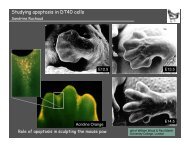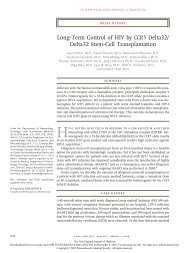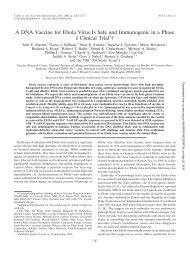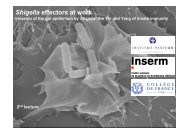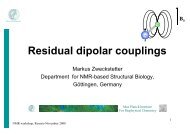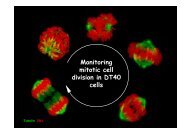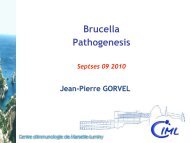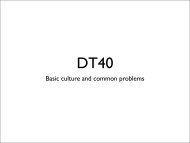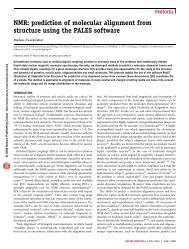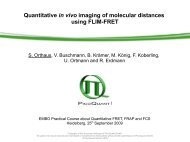pdf file - Events - EMBO
pdf file - Events - EMBO
pdf file - Events - EMBO
Create successful ePaper yourself
Turn your PDF publications into a flip-book with our unique Google optimized e-Paper software.
<strong>EMBO</strong> Plant DNA Repair and Recombination Workshop, Presqu'île de Giens, France 2007<br />
that at least several members of the RecQ family have non-redundant partly even<br />
antagonistic functions in Arabidopsis.<br />
----------------------------------------------------------------------------------------------------------------------------------<br />
T - 10. The Arabidopsis thaliana AtGR1/COM1 gene is essential for DNA repair and<br />
meiosis and relates yeastâ€s COM1/SAE2 to the human CtIP gene<br />
Clemens Uanschou, Tanja Siwiec, Andrea Pedrosa Harand, Claudia Kerzendorfer, Eugenio<br />
Sanchez-Moran, Maria Novatchkova, Svetlana Akimcheva, Franz Klein, Peter<br />
Schlogelhofer Dept. of Chromosome Biology, Max F. Perutz Laboratories/University of<br />
Vienna, A-1030 Vienna, Austria<br />
Meiotic recombination is initiated by DNA double strand breaks (DSBs), generated by a<br />
homolog of the archaebacterial topoisomerase subunit Top6A Spo11. As an intermediate<br />
of the DNA cleavage reaction, Spo11 is covalently linked to 5†termini of DNA. Release<br />
of Spo11 is mediated by cleaving ssDNA next to the DSB site, thereby liberating the Spo11<br />
protein attached to a few nucleotides. In budding yeast this release requires Rad50,<br />
Mre11 and Com1/Sae2. This study describes the identification and characterisation of the<br />
first COM1/SAE2 homologue of a higher eukaryote, the Arabidopsis thaliana<br />
AtGR1/COM1 gene. We provide evidence that AtGR1/COM1 is essential for male and<br />
female meiosis and for conferring resistance against mitomycin C (MMC) in plants.<br />
Mutations in the corresponding gene lead to defects in chromosome pairing, to DNA<br />
fragmentation and subsequently to sterile plants. We demonstrate that AtCOM1 acts<br />
downstream of AtSPO11-1 and upstream of AtDMC1 during meiosis. Furthermore, our<br />
data show that regular turn-over of AtSPO11-1 at DSB sites and DSB processing depends<br />
on AtGR1/COM1. Importantly, this study creates a so far unsuspected link between the<br />
yeast Com1/Sae2 and the mammalian CtIP protein, a DNA repair related protein, well<br />
conserved in higher eukaryotes.<br />
----------------------------------------------------------------------------------------------------------------------------------<br />
T - 11. Transposon-Induced Genome Rearrangements in Maize and Arabidopsis<br />
Thomas Peterson, Jianbo Zhang, Chuanhe Yu, Lakshminarasimhan Krishnaswamy, David<br />
Weber Genetics, Development and Cell Biology, Iowa State University, 50011 Ames Iowa,<br />
United States<br />
Since their discovery by McClintock, transposable elements have been associated with the<br />
generation of a variety of genome rearrangements, including deletions, direct and<br />
inverted duplications, and translocations. In addition to providing dispersed sequence<br />
homologies for ectopic recombination, transposons can induce genome rearrangements<br />
through alternative transposition reactions that utilize the termini of different elements.<br />
Transposition reactions involving transposon termini in direct orientation can generate<br />
deletions and inverted duplications. In addition, pairs of Ac termini in reversed<br />
orientation can undergo transposition reactions resulting in inversions, deletions, and<br />
translocations. In each of these cases, the rearrangement breakpoints are bounded by the<br />
characteristic footprint or target site duplications typical of Ac transposition reactions.<br />
These results show how alternative transposition reactions could contribute significantly<br />
to genome evolution by generating chromosome rearrangements, and by creating new<br />
genes through shuffling of coding and regulatory sequences (Zhang, Zhang and Peterson,<br />
2006). These alternative transposition reactions were first observed in natural maize<br />
variants, and have now been reproduced in transgenic maize and Arabidopsis plants. The<br />
system utilizes transgene constructs containing maize Ac termini in direct or reversed<br />
orientation. The action of Ac transposase on the Ac termini generates a variety of<br />
rearrangements, including deletions, inversions and translocations. In these<br />
rearrangements, one endpoint is at the Ac termini, and the other endpoint is at another<br />
genomic site. This transposition-based system provides an alternative to the cre-lox<br />
system for genome modifications. The current state of the project will be presented. To<br />
Page 11 sur 56



